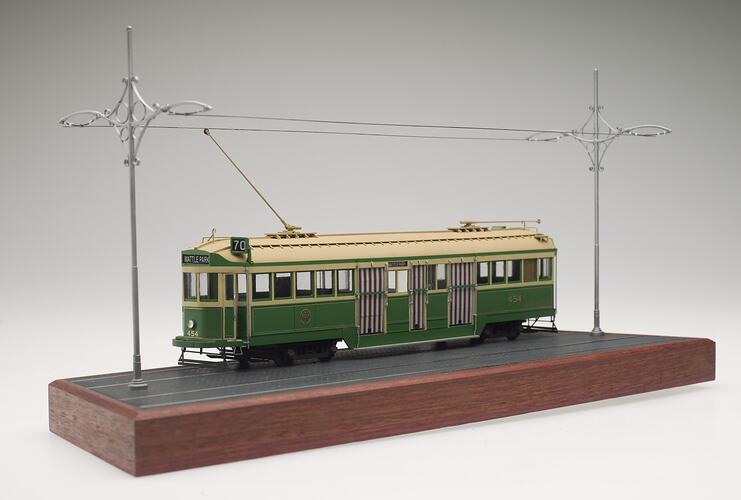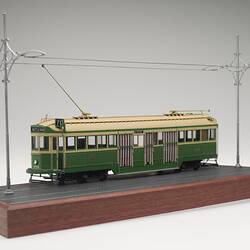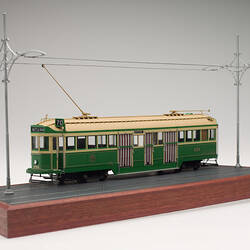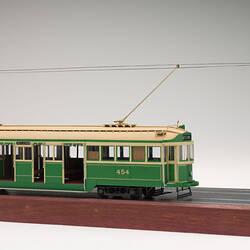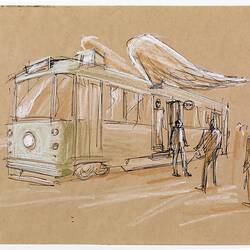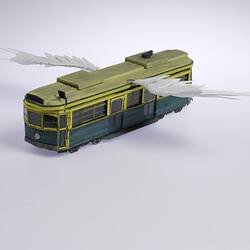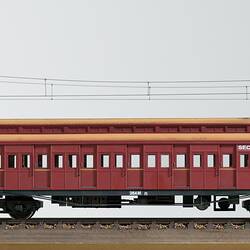Summary
Custom-built scale model constructed by Mr Gary Sneesby, Eccentric Engineering, Hughesdale, Victoria, 2007-8, depicting the W2-class drop-centre double-bogie standard-gauge electric tram No.454, built at the Melbourne & Metropolitan Tramways Board's Preston Workshops in 1927. Model scale: 1:48 (1/4-inch to the foot).
First introduced by the Melbourne & Metropolitan Tramways Board (MMTB) in 1923, the W-class tram design was intended from the outset to provide a standardised rollingstock for Melbourne's entire tramway system.
The MMTB was formed in 1919 as a single government authority to manage and operate all Melbourne's public tramways (except for two routes which remained under the operation of the Victorian Railways until 1959). The MMTB was given the responsibility of creating a unified modern electric tramway network by replacing old cable tram routes dating back to the 1880s and upgrading early municipal electric tram routes built between 1906 and 1921. By 1923, the MMTB had inherited a disparate fleet of 996 ageing cable tram cars and 163 electric trams built to 18 different designs that were limited in capacity, expensive to maintain and inefficient to operate. Over the following 35 years a total of 756 W-class trams were built by the MMTB. All had a similar basic form and external appearance. The combination of an open drop-centre section and enclosed saloons at either end provided one of the classic tram designs and was to prove ideally suited to Melbourne's ever changing weather and the need to quickly load and disembark large numbers of passengers during peak hour services. The W2-class design had an 'official' capacity for 52 seated and 93 standing passengers.
Tram No.454 was the first tram to appear from new in the MMTB's standard green and cream paint scheme that was reputedly developed to complement Melbourne's leafy tree-lined boulevards such as St Kilda Road, Victoria Parade and Royal Parade. Earlier W-class trams had been painted in a chocolate brown & cream paint scheme adapted from the colours of the Prahran & Malvern Tramways Trust.
Tram No.454 was based from new at the Camberwell Tram Depot on Riversdale Road, typically working on City-Wattle Park route 70, City-Burwood route 74 and City-Prahran route 77. The model depicts the tram destined for the Wattle Park terminus of route 70. First established by the Hawthorn Tramways Trust in 1916, the Wattle Park route ran from the Princes Bridge terminus along Batman Avenue, Swan Street and Riversdale Road to terminate at Elgar Road, South Box Hill. It was named after the 137 acre (55.4 hectare) public park in Riversdale Road that as established by the Hawthorn Tramways Trust in 1917, modelled on the American trolley parks designed to draw weekend patronage to the end of new tram lines. The park was later operated by the MMTB until 1983, then by the Metropolitan Transit Authority (the MET) until 1991. From 1937, Tram No.454 was based at the Essendon Depot in Mount Alexander Road.
Physical Description
Model fabricated in soldered brass. It is painted in the original late 1920s MMTB green & cream colour with deeper Hawthorn green body panels, cream window frames and a stone coloured vent roof with raised centre section. The tram is finished with the early gold MMTB logo, tram number and gold lining around the body panels. This colour scheme was replaced by the simplified Trawmays green and cream paint scheme during the late 1950s, which dropped the gold lining and featured a lighter shade of green paint produced by Dulux specifically for the MMTB. The two-digit route number destination boxes mounted above the left-hand motorman's door at either end were retrospectively fitted to all W2-class trams between 1929 & 1934. The model is also fitted with side destination signs (used from 1920s-1958) and the original style electric centre headlights on either end without later indicators or tail markers lights, which were retrospectively fitted to all W2-class trams during 1972-73.
Significance
First introduced by the newly formed Melbourne & Metropolitan Tramways Board (MMTB) in 1923, the W-class tram design was intended from the outset to provide a standardised rollingstock for Melbourne's entire tramway system, replacing ageing cable-trams dating back to the late 1880s and a multitude of early electric tram designs of limited capacity introduced by the various municipal tramways trusts between 1906 and 1921. Over the following 35 years a total of 756 W-class trams were built in eight design variations that all had a similar basic form and external appearance, creating one of the world's largest unified tram fleets of a single type.
By the early 1930s, W-class electric trams had became a ubiquitous part of Melbourne streetscapes and remain today, one of the most widely recognised symbols of Melbourne and its world-class tramway system. Images of the familiar green and cream painted W-class trams were widely reproduced on postcards, tourist publications and souvenirs of the city. In 1990, the National Trust classified the entire remaining W-class tram fleet in its first ever mass classification of moveable cultural heritage artefacts, in recognition of the W-class trams' contribution to Melbourne's social and cultural heritage.
More Information
-
Collecting Areas
-
Acquisition Information
Commission from Gary Sneesby - Eccentric Engineering, 26 Feb 2008
-
Modelmaker
Gary Sneesby - Eccentric Engineering, 40 Hotham Street, Hughesdale, Greater Melbourne, Victoria, Australia, 01 Nov 2007-28 Feb 2008
-
Maker of Item Modelled
Preston Workshops, Preston Workshops, Melbourne & Metropolitan Tramways Board (MMTB), Preston, Greater Melbourne, Victoria, Australia, 1927
-
User of Item Modelled
Melbourne & Metropolitan Tramways Board (MMTB), Melbourne, Greater Melbourne, Victoria, Australia, 1927-1983
MMTB was became part of the Metropolitan Transit Authority (the MET) in 1991. -
Model Name or Number
-
Brand Names
-
Classification
-
Category
-
Discipline
-
Type of item
-
Overall Dimensions
450 mm (Length), 144 mm (Width), 192 mm (Height)
-
Model Scale
1:48
-
References
[Book] Cross, N. E., et al. 1981. Destination City - Electric Tramway Rolling Stock of the Melbourne & Metropolitan Tramways Board., 1981, pp.30-55 Pages
-
Keywords
